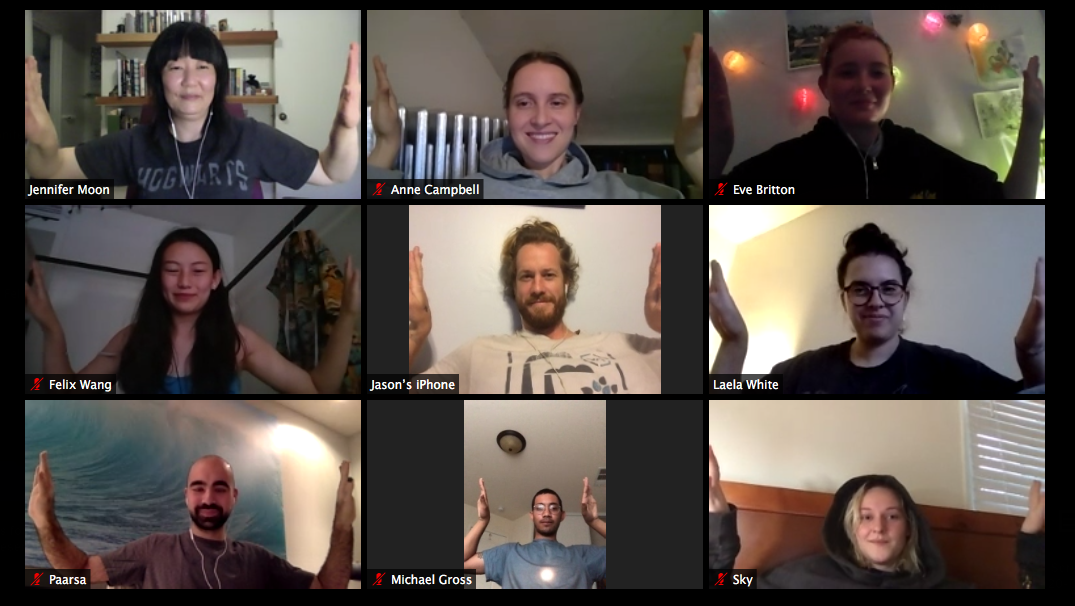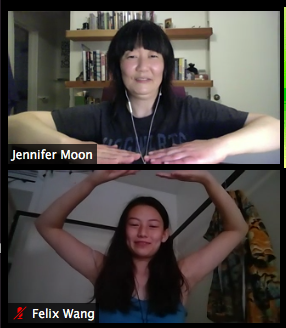On Virtual Touching (Beyond the Heart-Sphere)
Performed Experiment
On Virtual Touching is a 'performed experiment' conducted through the Zoom online conferencing platform. The experiment was created to explore the following questions: How important is physical proximity for one to feel the effects of physical touch? Can we "feel", physically and emotionally, each others' touch through the screen? Participants were directed to focus at the screen in a video-grid view, focus on each other, and mirror the posed action of "touching" each others' hands in the grid.
Participants all felt some kind of physical sensation in their hands and/or bodies during the experiment, as well as an emotional feeling of 'connectedness' or 'togetherness'. The experiment also raised questions about the influence of 'the apparatus' in virtual gathering, group dynamics when a group must gather non-physically, and mirroring at a distance.
When the COVID-19 Pandemic became widespread news around mid-March 2020, life as I knew it quickly became much more isolated. The number of people allowed to gather and share a physical space was cut down quickly. Concerts were cancelled, movie theaters and bars were closed. Physical distancing to slow the spread of the virus meant that my classes at Otis and my social interactions moved to the virtual sphere. My life has especially become dependent on the video platform Zoom. I wanted to know if a group of people could feel similar physical and emotional sensations over Zoom, as they might feel when sharing space together in a physical setting, like the feeling you get when you stand in a crowd at a concert. A feeling of tingling wholeness, of humanity shared.
Using some principles and theories written by Karen Barad in “On Touching—The Inhuman That Therefore I am (v1.1),” Diaphanes, 2012”, I wrote the following instructions and queries to facilitate a performance and discussion.
“When two hands touch, how close are they? What is the measure of closeness? Which disciplinary knowledge formations, political parties, religious and cultural traditions, infectious disease authorities, immigration officials, and policy makers do not have a stake in, if not a measured answer, to this question?” (p.1, pp2)
Is proximity really a necessary aspect for touch to be possible? When you consider quantum physics, when something is touching something else, are the atoms beside, against, next to, part of, connected to, the other atoms? Can we achieve a form of Heart-Brain Synchronization Through Nonphysical Contact?
Here I consulted research about the heart’s magnetic field. It can reach approximately three feet from our bodies. With this field in mind, there have been studies proving that the heart’s magnetic field can affect the heart rate of another person. This works both when touching, and when simply within reach of the other person’s heart-field. Can we extend the magnetic fields of our heart-field through the screen?
Lastly, there is the idea behind the Phantom limb effect and the Rubber Hand Illusion. The illusion comes on when the real and fake hands are stroked at the same time and speed for a minute or two. In combining the visual information with the touch sensations, the brain mistakenly concludes that the rubber hand must be part of the person's body. The exact cause of phantom pain is unclear, but it appears to come from the spinal cord and brain. ... A number of other factors are believed to contribute to phantom pain, including damaged nerve endings, scar tissue at the site of the amputation and the physical memory of pre-amputation pain in the affected area.
Experiment:
Experimenters/performers will try feel each others’ touch through the screen. If we see ourselves touching + being touched, can we “trick” our brains and bodies into “feeling” it?
This question is really in 2 parts:
1. Can we feel the feeling of touch in our bodies?
2. Can we feel the more vague feeling of “connectedness” in our bodies/brains/
wherever we feel that?
Medium and requirements:
Performed experiment over Zoom or another virtual gathering platform that allows for
grid view of simultaneous live video. Requires 2 or more people.
Consent
1. Does everyone consent to participate?
2. If you do, please turn on your screen.
3. If you do not, please turn off your video and mic.
4. Does everyone consent to being recorded?
I will Share my screen, with everyone being viewed in the Grid View, so that the
order of participants in the grid is the same for everyone.
Participants will will try to touch hands to each other within/through the
screen. Imagine “breaking through the grid”. Participants can continue as long as they want. After, the group can talk about how the feel and how they felt during the exercise, using the above two-part question as prompt.
After trying out the above with a group of people, we came to some conclusions as a group.
First, I realized that there was a technical issue with my directions when using Zoom as a platform: there is no standardized order of participants in the grid view. This is to say, not everyone is seeing the other participants in the same order in the grid. It is fairly random. Also, when a user shares their screen, the other participants can not see the Zoom platform of the person sharing the screen, and can therefore not see a standardized grid. The exception is that, the person hosting the “meeting“ is always first, the “self“ is second on their own screen, and the person who arrived first to the meeting is shown third. Therefore, the host and the first person are always first and third, with “you“ seeing yourself in between them. Therefore, everyone saw themselves between these two people. Extra energy must have been focused on those two participants, we thought!
I asked if anyone had felt a physical sensation. Everyone had. Then, I asked if anyone had felt an emotional sensation. Everyone had. We discussed that we were a group of people who already knew each other, who had shared physical space and also become emotionally open and connected through a process group over Zoom for the past 6 weeks or so prior to this experiment. Overall, it was interesting to think that we had, in some way, “felt“ each other through the screen.



